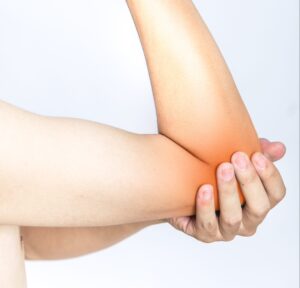What is Tennis Elbow?
It is an overuse injury from repetitive or forceful/explosive movements involving eccentric motion and/or in which the wrist frequently deviates from a neutral position. This can be from training errors, inadequate equipment or poor environmental conditions.
Who can get Tennis Elbow?
Tennis elbow can affect anyone, however is more common in people between 30 and 60 years of age. It appears to be more severe and of longer duration in females. The most commonly affected arm is the dominant arm. It is commonly seen in office workers (repetitive typing) or manual labour workers (carpenters etc).
Signs and Symptoms of Tennis Elbow?
Pain and tenderness over the elbow bone (lateral epicondyle)
Pain with gripping, twisting, lifting.
Some cases may have nerve involvement – nerve pain and neck range of motion restrictions.
Do I need an X-ray or MRI?
A diagnosis can be made based on the history of the condition and a physical examination. X-rays may be used to help rule out other causes of elbow pain, such as arthritis. An ultrasound or magnetic resonance imaging (MRI) scan will show the degenerative changes or small tears in the tendon, but is rarely required.
Tennis Elbow Treatment
Evidence tells us that strength exercises are the most effective way of treating tennis elbow, with adjuncts of manual therapy (lateral elbow glides and C5 glides if radial nerve involvement. (L.Bisset et al 2015, Cleland et al 2013).
Strength exercises can not only help settle the pain, but also reduce the risk of the pain returning.
CLICK HERE TO VIEW THE 2 EASIEST, AT HOME STRENGTH EXERCISES!
Each patient should be treated based on the history and the findings. Common treatments include:
- Load management: – Reducing or stopping the aggravating activity for a short period- Progressive loading and strengthening to improve load capacity
- Ergonomic advice (for example, the amount of time spent out of neutral wrist position is strongly associated with tennis elbow)
- Correction of biomechanics if required for return to sport.
Tips & Tricks:
- Avoid the aggravating activities or positions that bring on your pain
- Carry things with your palm up
- Carry things close to the body
- Load the tendon with exercises, but reduce manual labour
- There should be no pain when performing exercises
Patients can also be reassured that some cases will improve without intervention and just information regarding modification of aggravating activities, ergonomic advice and reassurance that their condition will eventually settle.
Cortisone injections for tennis elbow… do they work?
Corticosteroid injections are NOT recommended. In a study by Vicenzino et al 2006, 198 participants got assigned to three groups (physiotherapy interventions, corticosteroid injections and ‘the wait and see approach’). The corticosteroid group had most reported recurrences at 72%.
Is there any evidence for any other treatment options?
Chiropractic manipulation
Can provide short term pain relief, however has no effect on long term outcome.
Bracing/taping
There is conflicting evidence for the effectiveness of bracing/taping compared with placebo or no treatment.
Acupuncture/dry needling
Conflicting evidence, but may be more effective than placebo and ultrasound at relieving pain and improving self-assessed treatment benefit in the short term.
Laser therapy
May be beneficial in short term compared with placebo, likely no difference between laser and other active interventions in the short or long term.
Ultrasound
No more effective than placebo for pain relief or self-perceived global improvement in short term.
Shock wave therapy
Little or no benefit in reducing pain or improving function.
Platelet rich plasma injections
No benefit.
If you have any questions, or would like our help, please do not hesitate to get in touch at clinicalphysiostives.com.au
References:
1) Physiotherapy management of lateral epicondylalgia – Bisset, Vicenzino (2015)
•Hypoalgesic and sympathoexcitatory effects of mobilization with movement for lateral epicondylalgia – Paungmali, O’Leary, Souvlis, Vicenzino (2003)
2) Specific manipulative therapy treatment for chronic lateral epicondylalgia produces uniquely characteristic hypoalgesia – Vicenzino, Paungmali, Buratowski, Wright (2001)
•Manipulation of the wrist for management of lateral epicondylitis: A randomized pilot study – Struijs, Damen, Bakker, Blankevoort, Assendelft, Van Dijk (2003)
3) Incorporation of Manual Therapy Directed at the Cervicothoracic Spine in Patients with Lateral Epicondylalgia: A Pilot Clinical Trial – Cleland, Flynn, Palmer (2013)
4) A randomized controlled trial of eccentric vs. concentric graded exercise in chronic tennis elbow (lateral elbow tendinopathy) – Peterson, Butler, Eriksson, Svardsudd (2014)
5) Mobilisation with movement and exercise, corticosteroid injection, or wait and see for tennis elbow: randomised trial – Bisset, Beller, Jull, Brooks, Darnell, Vicenzino (2006)
6) Addition of isolated wrist extensor eccentric exercise to standard treatment for chronic lateral epicondylosis: A prospective randomized trial – Tyler, Thomas, Nicholas, Malachy, McHugh (2010)
7) Is tendon pathology a continuum? A pathology model to explain the clinical presentation of load-induced tendinopathy – Cook & Purdam (2009)



